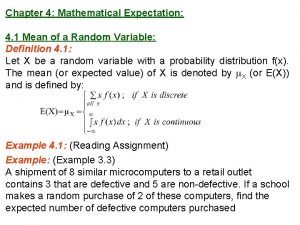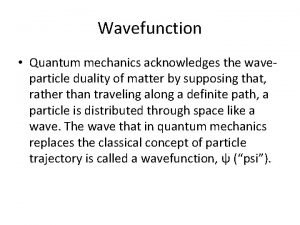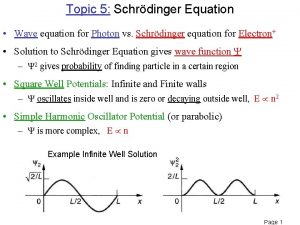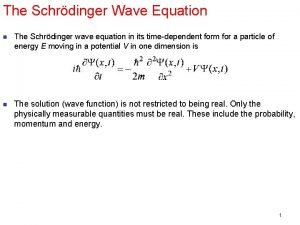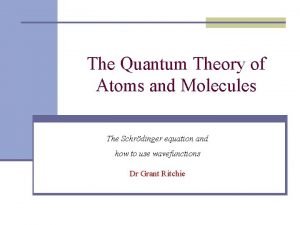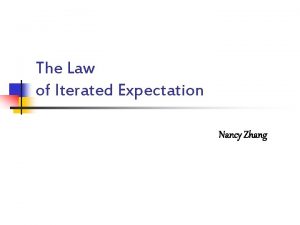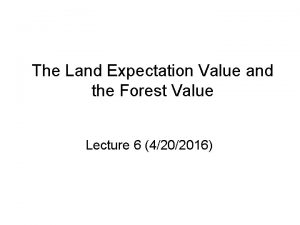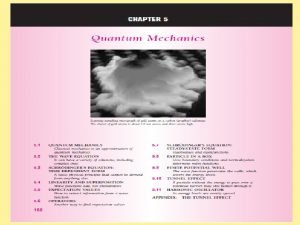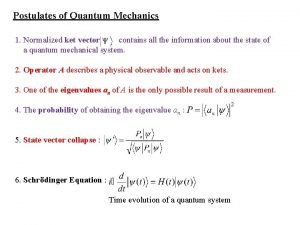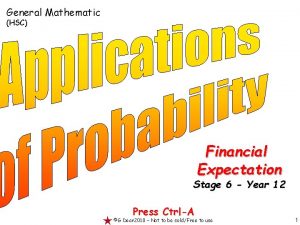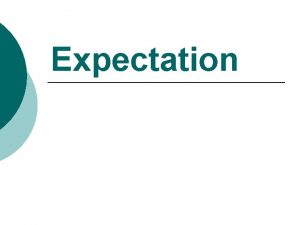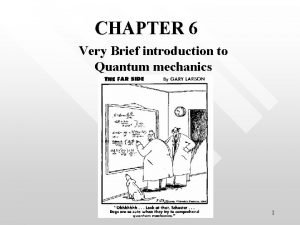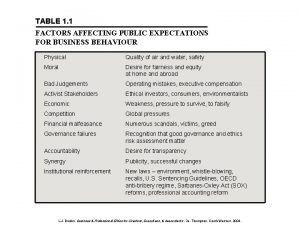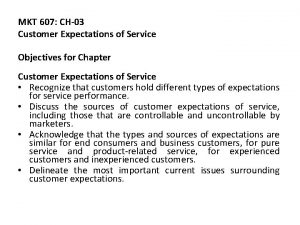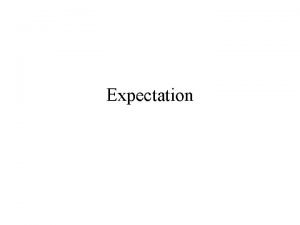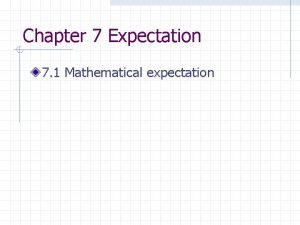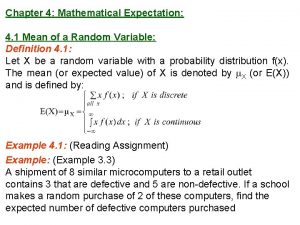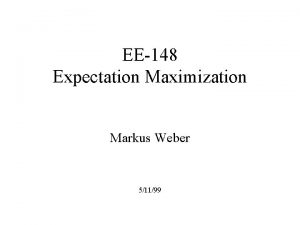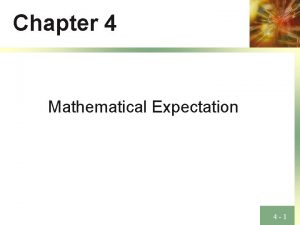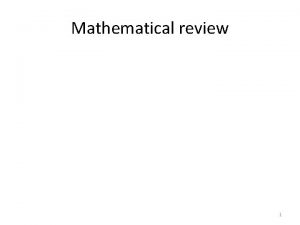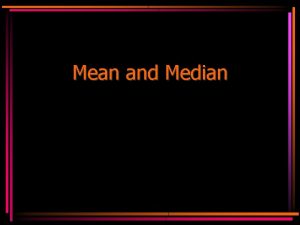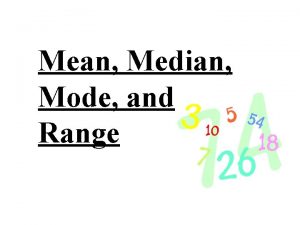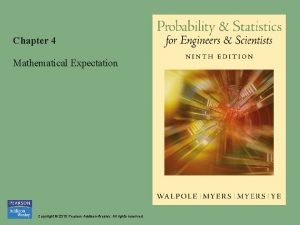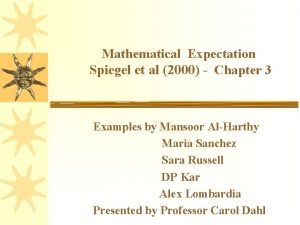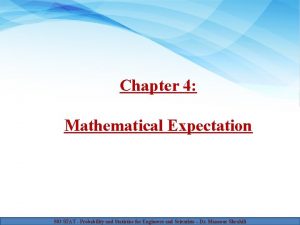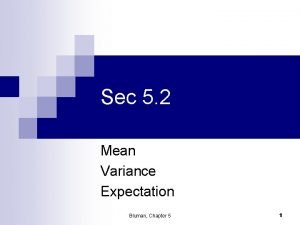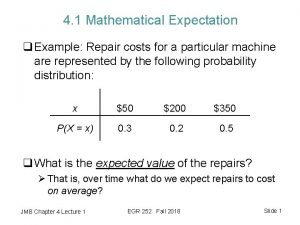Chapter 4 Mathematical Expectation 4 1 Mean of





















- Slides: 21

Chapter 4: Mathematical Expectation: 4. 1 Mean of a Random Variable: Definition 4. 1: Let X be a random variable with a probability distribution f(x). The mean (or expected value) of X is denoted by X (or E(X)) and is defined by: Example 4. 1: (Reading Assignment) Example: (Example 3. 3) A shipment of 8 similar microcomputers to a retail outlet contains 3 that are defective and 5 are non-defective. If a school makes a random purchase of 2 of these computers, find the expected number of defective computers purchased

Solution: Let X = the number of defective computers purchased. In Example 3. 3, we found that the probability distribution of X is: x F(x)=p(X=x) or: 0 1 2

The expected value of the number of defective computers purchased is the mean (or the expected value) of X, which is: = (0) f(0) + (1) f(1) +(2) f(2) (computers) Example 4. 3: Let X be a continuous random variable that represents the life (in hours) of a certain electronic device. The pdf of X is given by: Find the expected life of this type of devices.

Solution: (hours) Therefore, we expect that this type of electronic devices to last, on average, 200 hours.

Theorem 4. 1: Let X be a random variable with a probability distribution f(x), and let g(X) be a function of the random variable X. The mean (or expected value) of the random variable g(X) is denoted by g(X) (or E[g(X)]) and is defined by: Example: Let X be a discrete random variable with the following probability distribution x 0 1 F(x) Find E[g(X)], where g(X)=(X 1)2. 2

Solution: g(X)=(X 1)2 = (0 1)2 f(0) + (1 1)2 f(1) +(2 1)2 f(2) = ( 1)2 + (0)2 +(1)2

Example: In Example 4. 3, find E Solution: .

4. 2 Variance (of a Random Variable): The most important measure of variability of a random variable X is called the variance of X and is denoted by Var(X) or . Definition 4. 3: Let X be a random variable with a probability distribution f(x) and mean . The variance of X is defined by: Definition: The positive square root of the variance of X, called the standard deviation of X. Note: Var(X)=E[g(X)], where g(X)=(X )2 , is

Theorem 4. 2: The variance of the random variable X is given by: where Example 4. 9: Let X be a discrete random variable with the following probability distribution x 0 1 2 3 F(x) 0. 15 0. 38 0. 10 0. 01 Find Var(X)= .

Solution: = (0) f(0) + (1) f(1) +(2) f(2) + (3) f(3) = (0) (0. 51) + (1) (0. 38) +(2) (0. 10) + (3) (0. 01) = 0. 61 1. First method: =(0 0. 61)2 f(0)+(1 0. 61)2 f(1)+(2 0. 61)2 f(2)+ (3 0. 61)2 f(3) =( 0. 61)2 (0. 51)+(0. 39)2 (0. 38)+(1. 39)2 (0. 10)+ (2. 39)2 (0. 01) = 0. 4979 2. Second method: = (02) f(0) + (12) f(1) +(22) f(2) + (32) f(3) = (0) (0. 51) + (1) (0. 38) +(4) (0. 10) + (9) (0. 01) = 0. 87 =0. 87 (0. 61)2 = 0. 4979

Example 4. 10: Let X be a continuous random variable with the following pdf: Find the mean and the variance of X. Solution: 5/3 17/6 – (5/3)2 = 1/8

4. 3 Means and Variances of Linear Combinations of Random Variables: If X 1, X 2, …, Xn are n random variables and a 1, a 2, …, an are constants, then the random variable : is called a linear combination of the random variables X 1, X 2, …, Xn. Theorem 4. 5: If X is a random variable with mean =E(X), and if a and b are constants, then: E(a. X b) = a E(X) b a. X b = a X ± b Corollary 1: E(b) = b (a=0 in Theorem 4. 5) Corollary 2: E(a. X) = a E(X) (b=0 in Theorem 4. 5)

Example 4. 16: Let X be a random variable with the following probability density function: Find E(4 X+3). Solution: 5/4 E(4 X+3) = 4 E(X)+3 = 4(5/4) + 3=8 Another solution: ; g(X) = 4 X+3 E(4 X+3) =

Theorem: If X 1, X 2, …, Xn are n random variables and a 1, a 2, …, an are constants, then: E(a 1 X 1+a 2 X 2+ … +an. Xn) = a 1 E(X 1)+ a 2 E(X 2)+ …+an. E(Xn) Corollary: If X, and Y are random variables, then: E(X ± Y) = E(X) ± E(Y) Theorem 4. 9: If X is a random variable with variance and b are constants, then: Var(a. X b) = a 2 Var(X) and if a

Theorem: If X 1, X 2, …, Xn are n independent random variables and a 1, a 2, …, an are constants, then: Var(a 1 X 1+a 2 X 2+…+an. Xn) = Var(X 1)+ Var (X 2)+…+ Var(Xn) Corollary: If X, and Y are independent random variables, then: · Var(a. X+b. Y) = a 2 Var(X) + b 2 Var (Y) · Var(a. X b. Y) = a 2 Var(X) + b 2 Var (Y) · Var(X ± Y) = Var(X) + Var (Y)

Example: Let X, and Y be two independent random variables such that E(X)=2, Var(X)=4, E(Y)=7, and Var(Y)=1. Find: 1. E(3 X+7) and Var(3 X+7) 2. E(5 X+2 Y 2) and Var(5 X+2 Y 2). Solution: 1. E(3 X+7) = 3 E(X)+7 = 3(2)+7 = 13 Var(3 X+7)= (3)2 Var(X)=(3)2 (4) =36 2. E(5 X+2 Y 2)= 5 E(X) + 2 E(Y) 2= (5)(2) + (2)(7) 2= 22 Var(5 X+2 Y 2)= Var(5 X+2 Y)= 52 Var(X) + 22 Var(Y) = (25)(4)+(4)(1) = 104

4. 4 Chebyshev's Theorem: * Suppose that X is any random variable with mean E(X)= and variance Var(X)= and standard deviation . * Chebyshev's Theorem gives a conservative estimate of the probability that the random variable X assumes a value within k standard deviations (k ) of its mean , which is P( k <X< +k ). * P( k <X< +k ) 1

Theorem 4. 11: (Chebyshev's Theorem) Let X be a random variable with mean E(X)= and variance Var(X)= 2, then for k>1, we have: P( k <X< +k ) 1 P(|X | < k ) 1 Example 4. 22: Let X be a random variable having an unknown distribution with mean =8 and variance 2=9 (standard deviation =3). Find the following probability: (a) P( 4 <X< 20) (b) P(|X 8| 6)

Solution: (a) P( 4 <X< 20)= ? ? P( k <X< +k ) 1 ( 4 <X< 20)= ( k <X< +k ) 4= k 4= 8 k(3) or 4= 8 3 k 3 k=12 k=4 20= + k 20= 8+ k(3) 20= 8+ 3 k 3 k=12 k=4 Therefore, P( 4 <X< 20) , and hence, P( 4 <X< 20) (approximately)

(b) P(|X 8| 6)= ? ? P(|X 8| 6)=1 P(|X 8| < 6)= ? ? P(|X | < k ) 1 (|X 8| < 6) = (|X | < k ) 6= k 6=3 k k=2 P(|X 8| < 6) 1 1 P(|X 8| < 6) P(|X 8| 6) Therefore, P(|X 8| 6) (approximately)

Another solution for part (b): P(|X 8| < 6) = P( 6 <X 8 < 6) = P( 6 +8<X < 6+8) = P(2<X < 14) (2<X <14) = ( k <X< +k ) 2= k 2= 8 k(3) 2= 8 3 k 3 k=6 k=2 P(2<X < 14) P(|X 8| < 6) 1 P(|X 8| < 6) 1 1 P(|X 8| < 6) P(|X 8| 6) Therefore, P(|X 8| 6) (approximately)
 Mathematical expectation definition
Mathematical expectation definition Mathematical economics vs non mathematical economics
Mathematical economics vs non mathematical economics Expectation for webinar
Expectation for webinar Operators in quantum mechanics
Operators in quantum mechanics Schrodinger wave equation
Schrodinger wave equation Wave reflection formula
Wave reflection formula Expectation value of energy in quantum mechanics
Expectation value of energy in quantum mechanics Law of iterated expectations
Law of iterated expectations Soil expectation value
Soil expectation value Teamwork problem solving
Teamwork problem solving Quantum wave equation
Quantum wave equation Prayer point for expectations
Prayer point for expectations Ket 0 and ket 1
Ket 0 and ket 1 What is ironic contrast
What is ironic contrast Expectation in general mathematics
Expectation in general mathematics Expectation value
Expectation value Service level expectation
Service level expectation Possible levels of customer expectations
Possible levels of customer expectations Expectation value in quantum mechanics
Expectation value in quantum mechanics Factors affecting public expectation for business behaviour
Factors affecting public expectation for business behaviour Dual customer expectation levels
Dual customer expectation levels Moment generating function examples
Moment generating function examples
